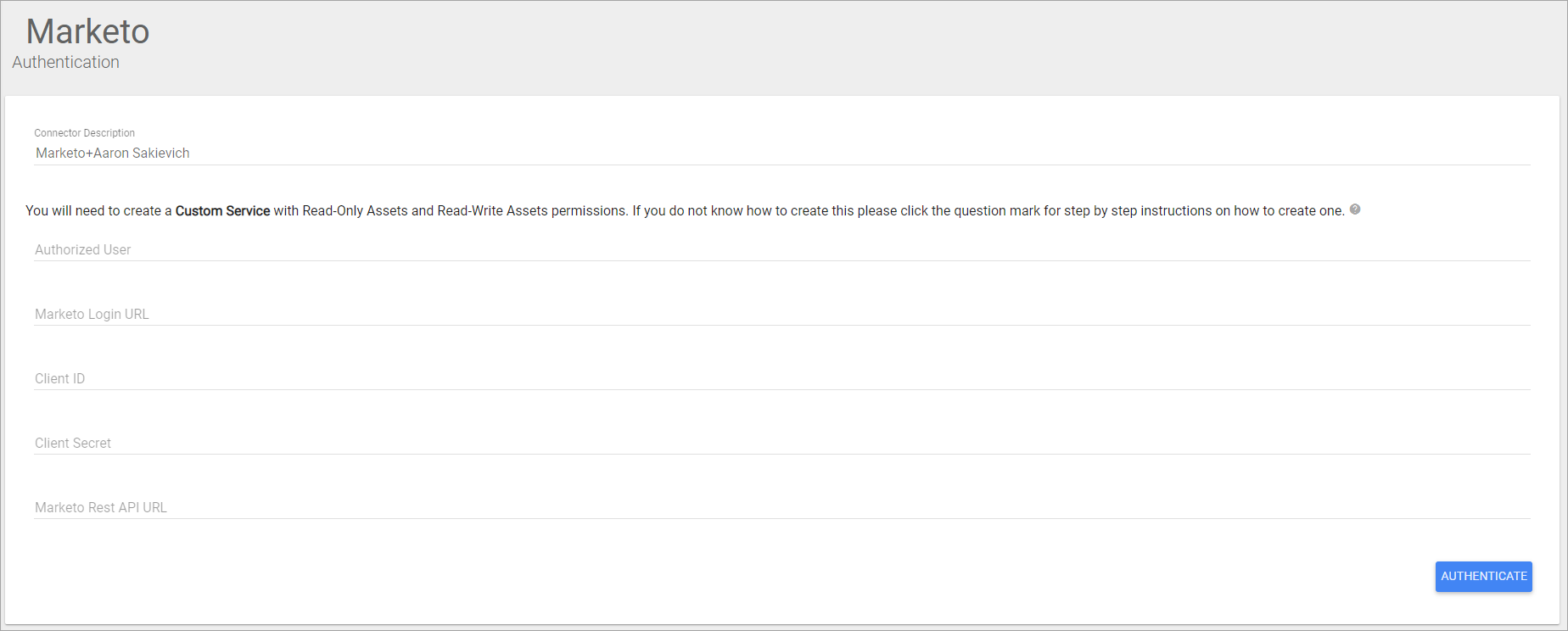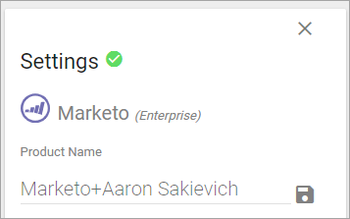Versions Compared
| Version | Old Version 22 | New Version Current |
|---|---|---|
| Changes made by | ||
| Saved on |
Key
- This line was added.
- This line was removed.
- Formatting was changed.
In Marketo
In Marketo, click Admin then navigate to LaunchPoint.

In LaunchPoint, select New to create a new custom service

The New Service modal will appear. Fill out the following:

Display Name - Create a name for your service that describes it is used to connect to RAY Enterprise.
Service - Select Custom. At this point, two more fields will appear under Settings.
Description - Give the service a description.
API Only User - It is recommended that this be a pseudo-user, not an individual as you may need to change an individual's permissions if there are personal/process changes.
This will not prevent other Marketo users from using the Chrome extension if they are logged into your Marketo account.
This user must be set up with the API Role.
Your API Role must include the following permissions:
Read-Only Assets
Read-Write Activity
Read-Write Assets
Read-Write Lead
Approve Assets
If the user doesn’t have the correct permissions we will get a
603“access denied” response and we will display a notification in your extension.
Click Create.
Select View Details on the service you just created and you will see a modal that displays the following values that you should have available when you link Marketo from the RAY Enterprise Marketplace:

Client ID
Client Secret
Authorized User
You will also need the Marketo Login URL and the Marketo Rest API URL.
The Marketo Login URL is simply the URL of your Marketo instance.
You can find the Marketo Rest API URL under Web Services. It is the Endpoint field in the REST API panel.
In
RAYEnterprise’s Marketplace app
Making the connection
Log into the RAY Enterprise Marketplace.
Select the Product Menu.
After reaching out to support@lingotek.com you should see a subscription to a Marketo account.
The new Marketo subscription will appear as disconnected.
Click the disconnected Marketo Product line.

On the next screen, you will see inputs from your newly created Service in Marketo as well as the Rest API URL and Marketo Login URL.

Fill out those fields and select Authenticate.
After successful authentication, you will be taken back to the Product Page and your Marketo subscription will be connected.

Select your Marketo Subscription and complete your configuration.
Configure Marketo Settings
Log into Marketplace and go to the Products menu.
Select the newly connected Marketo integration.

Select the pencil icon to give the product a name, then select the save icon. This is helpful and recommended if you have multiple instances of Marketo that need a subscription.

Expand Marketo Connection and select your source and target languages. Select Save Changes. You are also given a read-only view of the Authorized User, Marketo Login URL, and Marketo Rest API URL for reference.

Lock Targets in "Current" Status - Targets that reach the current status will be locked, preventing them from receiving any further updates from the TMS. This can be manually changed in the RAY Enterprise Inside connector. This setting is global for all Translation Profiles.
Translation Profiles
Expand the Translation Profiles section. The automatic and manual profiles have already been created for you. To create a new profile you can select the plus next to the Add Profile header or you can simply modify the automatic and manual profiles.
Give the Profile a name to help your content managers distinguish the profile.
Choose the targets that should be used with this translation profile. This allows you to prevent some languages from being used for specific content types.
Download - Choose if you want your content to download automatically or manually when they complete the translation process. This setting cannot be adjusted for the automatic and manual profiles.
Auto-Upload Settings – Choose to automatically upload untracked content at a regular interval.
Project - Use the dropdown to select which project in the RAY Enterprise TMS the Marketo content should be uploaded into.
Workflow - Use the dropdown to select which workflow should be used to translate your Marketo content.
Primary Filter - The FPRM filter that should be initially applied to your content
Secondary Filter - the FPRM filter should be applied to your content after the Primary filter.
It is highly recommended that you use the Marketo Default filters that are already selected in this drop-down. If your content needs special filters, please speak with support@lingotek.com.
Document Metadata - Populating any of these fields will add that value to the corresponding metadata field in RAY Enterprise upon upload.
Select Save Changes.
Assign content types to profiles - You can translate content types differently by assigning them to different profiles. For example, you may want one content type to get a high-quality translation, and others, simple machine translation.
All your content types are assigned to the Automatic profile by default, but you can remove them from the automatic profile and move them to other profiles.
If you do not want a content type to receive translation, then do not assign it to a profile, and your content managers will not be able to upload it to the TMS.
User Manager
Expand the User Manager panel. Use this panel to choose which of your community members should be able to use this integration to upload content from your connector. Simply add/remove users as necessary. Please note that you can only add users who have access to the Marketplace application.
Things to be aware of
Translated email and landing page assets are associated with their source asset’s template.
Newly created or updated assets can take a few minutes to finish processing in Marketo. Some fields may be missing in translated assets if you upload the source to RAY Enterprise immediately after it is created or changed,
Marketo API does not support creating landing pages that include YouTube or social media links. If your source content includes these types of links, you will get the following error from Marketo. "Code: 709. Message 9748 Social content type is not supported for landing page."
Marketo’s API only supports pixel integer values for CSS formating.
Marekto API only supports hex-color codes (e.g., Must be "#00FF25", not "green").
On this page:
| Table of Contents |
|---|